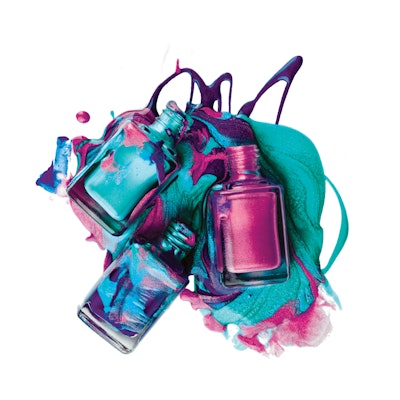By Katie O’Reilly

1. Acknowledge the emotional aspect of organizing.
Acknowledge the emotional aspect of organizing. Feeling overwhelmed is normal, says Raleigh, North Carolina-based professional organizer and life coach Julie Coraccio. “So is sadness,” she says, “especially if you have items you’re attached to or if you’ve lost money because, say, a shipment of nail polish went bad.” Coraccio adds, “It’s also normal to be angry at yourself for waiting so long to de-clutter, or for realizing you’ve lost clients because of not being organized.”
2. Come up with a vision.
Sit down and ask yourself how you want your salon to look. “Think about whether you want all your nail colors in one place or whether you want a more private station in the back,” says Cohen. “Make sure your vision shows your offerings for clients upfront and accounts for an out-of-sight room for supplies.” Beth Becher, owner of New York City-based B Organized, says, “Come up with a road map and know your timeframe and who you’ll be working with. That way, you’re able to take a step back and say, I’m not overwhelmed. I have a plan.” If one aspect of your salon is bothering you, start there. “If you’re losing money because you aren’t paying bills on time, begin by devising a system for that,” says Corracio. “And if you’re easily overwhelmed, start with something small, like organizing your purse, to build your confidence and flex those organizing muscles.” Kirsten Fisher, owner of Tampa’s Imagine Home Organization, recommends breaking your project into tiny steps. “Tell yourself you’re not going to get through all your tasks today, but resolve to do something small—say, sorting your polish by color and throwing out what’s empty or dry or expired,” she advises.
3. Consider seeking help.
Calling in a friend who’s not involved in your business can make a huge difference, says Fisher. Or, if your place is messy to the point that you’re sick about it or you don’t even want to go into work, Cohen believes it’s a good idea to hire someone. “It’s worth the money because a good organizer should leave you with a system and easy tips,” she says.
4. Get ready to purge.
Expect many of the emotions discussed in Step 1 to surface during this phase because there’s a lot you won’t be immediately sure about. As you work through your stuff, Fisher suggests the following questions: Is it broken? Is it no longer in fashion? Does no one ever choose it? Says Cohen, “If you’re really on the fence about something, take it out and, after a few days, see if you’ve used it. If not, toss it into your Halloween ‘wacky colors’ box.” She admits that it’s hard to get rid of things. “We’re tied to them for various reasons,” Cohen says. “But, at the end of the day, it’s just stuff.”

5. Learn to let go.
The hardest part of a purge can be getting rid of an investment you thought would be popular, but wasn’t, Fisher says.
“Acknowledge that as an entrepreneur, you take risks and, naturally, some won’t pay off,” she says. “It always makes people feel better if they can donate or resell it.”
6. Sort what’s left.
You don’t get to buy any cool new containers until you’ve mastered this step, per Fisher. “Until you’re sorted,” she says, “you don’t know what you need. Once you take stock of what you’re keeping, come up with different categories.” For instance, group your standard polish together, then do the same for your gel polish and art supplies. “Think about how you’ll best access each supply group,” Fisher says. “If you use something fairly often, make sure not to store it on a high shelf. Always make things as easy as possible to put back.” Cohen stresses that everything must have a place. “Think of your salon or workspace like a jigsaw puzzle,” she says. “If it doesn’t have a place, does it really belong?”
7. Now treat yourself to a trip to The Container Store.
After you’ve figured out where you’ll keep your things, you can search for exactly what you need. “Make sure you’re making the best use of your space,” says Fisher. “Do you need a wall rack or a shelving system? Take careful measurements to ensure that you’re buying the right size shelf at the best height.”

8. Use a label maker.
Once you have your supplies, it’s time to make your mark, so to speak. “Label everything, even if it seems super obvious,” says Becher. “Spell it out—cotton balls, remover, nail polish—so anyone in your salon can follow along. Everything must be assigned a place, and each designated place or container must be labeled.”
9. Pat yourself on the back.
Revel in the sense of accomplishment that comes with not wanting to pull your hair out every time you look in your supply closet. “You’ll have found stuff you didn’t know you had and it won’t take long to start saving money thanks to your newfound organization,” says Becher. “Those visual results, and the good feelings in the end, are what will fuel you moving forward.”
10. Come up with a maintenance plan.
Most experts we spoke with recommend an initial organizational overhaul, followed by an annual revisit. “January or September are, psychologically, good times for this,” notes Becher. Be sure to take stock of your supply room and stations every few months so as to ensure expired and damaged products are thrown out and replaced—a practice that has the added benefit of encouraging you to prioritize those products nearing expiration. “As long as your organizing systems are working, keep them,” says Coraccio. “Don’t re-establish your systems too often,” echoes Fisher. “You want your investments in shelving or containers to last as long as possible. Resolve to put aside two hours each month to make sure everything is where it belongs and practice daily maintenance.” After all, once you have a good system in place, you’ll find yourself investing in seconds of organizing per day—rather than hours per month.
Overwhelmed? NAPO can help.
 Nail polish isolated on white background
Nail polish isolated on white background
Sometimes our stuff can be, well, too much. The experts recognize this and, hence, The National Association of Professional Organizers (NAPO) declared January Get Organized Month. Designed to bring awareness to decluttering, NAPO’s more than 4,000 members focus on the ways in which getting organized empowers people to regain control over their time, possessions, inboxes and surroundings—through time-management practices, storage solutions and other measures to improve long-term productivity and organization. For a referral to an organizing pro in your area, visit napo.net.
What are your best organization tips? Let us know in the comments below!
[Images: Getty Images; Dmax-Foto/Istock; Orodrigues/Istock; Nik_Merkulov-Istock]
This story was originally published in the February 2017 issue of NAILPRO.











